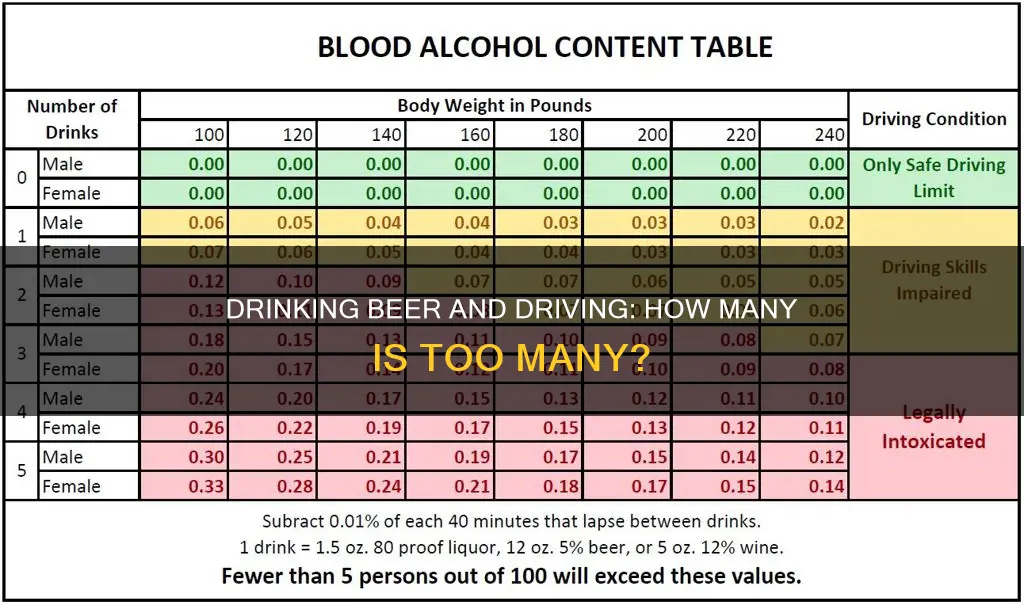
Drinking and driving is a serious issue that can lead to devastating consequences, including injuries and fatalities. While the legal blood alcohol content (BAC) limit for driving is typically set at .08% in many places, the number of beers one can consume before reaching this limit varies across individuals. Factors such as body size, weight, gender, metabolic rate, food consumption, and the alcohol content of the beer play a role in determining BAC levels. It's important to note that drinking any amount of alcohol can impair judgment and increase the risk of accidents. The safest option is to refrain from drinking and driving altogether.
| Characteristics | Values |
|---|---|
| Blood Alcohol Content (BAC) Limit | 0.08% |
| Number of Beers to Reach BAC Limit | 3.5 regular 12-ounce beers for a 180-lb man; 2.5 regular 12-ounce beers for a 140-lb woman |
| Metabolism Rate | 1 drink per hour |
| Gender | Men generally have a higher BAC tolerance than women |
| Weight | A higher weight is associated with a higher BAC tolerance |
| Food Consumption | Food in the system can affect BAC |
| Time of Day | Time of day can impact BAC |
| Age | Age can impact BAC |
| Alcohol by Volume (ABV) | Craft beers often have a higher ABV, which can affect BAC more significantly |
What You'll Learn

Variables affecting blood alcohol content
Several variables can affect an individual's blood alcohol content (BAC) when drinking beer or other alcoholic beverages. These factors influence how quickly alcohol is absorbed into the bloodstream and the overall BAC level. Here are some key variables to consider:
Weight and Body Composition
Weight plays a significant role in determining BAC levels. Typically, individuals who weigh more have a higher water content in their bodies. Since water dilutes alcohol, a heavier person will generally have a lower BAC level compared to someone who weighs less, even when consuming the same amount of alcohol. Additionally, body composition, particularly the percentage of body fat, is important. Alcohol can distribute throughout the body via the circulatory system and enters most tissues except bone and fat. As the percentage of body fat increases, the concentration of alcohol in the lean tissues is proportionally higher.
Number of Drinks Consumed
The more alcoholic beverages consumed, the higher the BAC level will rise. The speed of consumption also matters—drinking multiple drinks in a short period will lead to a higher BAC.
Gender
Gender influences BAC levels due to differences in body composition and the way alcohol is metabolized. Generally, men have more water and less fat in their bodies compared to women. Since alcohol easily enters fat cells, women tend to have higher BAC levels than men after consuming the same amount. Additionally, women produce less alcohol dehydrogenase, the enzyme responsible for metabolizing alcohol. This results in alcohol remaining in a woman's bloodstream longer, leading to higher BAC levels.
Age
Age also affects BAC levels. After consuming an alcoholic beverage, older adults tend to have higher BAC levels compared to younger adults.
Food Consumption
Eating before or while drinking can impact BAC levels. Food can absorb some alcohol, reducing the amount that enters the bloodstream. Larger meals, especially when consumed close to the time of drinking, can lower the peak BAC.
Metabolic Rate and Individual Tolerance
Each person's metabolic rate varies, affecting how quickly they process alcohol. Additionally, individual tolerance levels play a role, with some people having a higher tolerance and thus being able to consume more before reaching the same BAC level as someone with a lower tolerance.
Alcohol Content of Beverages
The alcohol content of the beverages consumed is crucial. Craft beers, IPAs, stouts, and ales often have higher alcohol by volume (ABV) levels, which will impact BAC levels more significantly. On the other hand, light beers have a lower average ABV, allowing individuals to consume more before reaching the legal limit.
It is important to remember that these variables interact in complex ways, and the overall effect on BAC levels can be challenging to predict with complete accuracy. The safest option is to avoid driving after consuming any amount of alcohol, as even small amounts can impair judgment and reflexes.
Enjoying Beer at Camp Nou: What's the Deal?
You may want to see also

Metabolising alcohol
When a person consumes alcohol, it is first absorbed into the bloodstream from the stomach and intestines. About 20% of alcohol is absorbed through the stomach, while the majority is absorbed through the small intestine. A small amount of alcohol is eliminated through the breath, urine, and fatty acids, with approximately 10% exiting the body through these routes.
In the liver, ADH breaks down alcohol molecules into acetaldehyde, a highly toxic and carcinogenic chemical. This metabolite is then converted into acetate by ALDH. Finally, acetate is metabolised into water and carbon dioxide, which the body can easily eliminate. However, the presence of acetaldehyde, even for a small period, can cause significant damage to the body, especially the liver and pancreas. This damage can lead to fatty liver disease and subsequent liver cirrhosis in long-term alcoholics.
The rate at which alcohol is metabolised varies from person to person and depends on factors such as age, weight, gender, metabolism, and food consumption. On average, a healthy person can metabolise about one standard drink per hour. However, this rate can be slower in older adults and individuals with a higher body fat percentage. Additionally, women tend to have higher blood alcohol levels than men after consuming the same amount of alcohol, and the effects of alcohol usually occur more quickly and last longer in women.
It is important to note that there is no way to speed up the alcohol metabolisation process. Once alcohol enters the bloodstream, it can only be eliminated through the body's natural processes. While certain substances like caffeine or water may make a person feel more alert, they do not remove alcohol from the system any faster. Therefore, the safest option is to refrain from driving if you have been drinking and to give your body enough time to metabolise the alcohol fully.
Beer and Orajel: A Safe Mix?
You may want to see also

Gender differences
The number of beers a person can drink and still drive varies depending on several factors, including their weight, gender, metabolic rate, and the alcohol content of the beer. While there is no definitive answer to the question of how many cans of beer a person can drink and still drive, it is important to consider the legal and safety implications of drinking and driving.
There are several gender differences to consider when discussing how many cans of beer a person can drink and still drive. Here are some key points:
- Body Composition: Women tend to have a higher body fat percentage and lower body water percentage than men. Since fat retains alcohol while water dilutes it, women generally reach higher blood alcohol concentrations than men when consuming the same amount of alcohol. This means that women may be more likely to exceed the legal blood alcohol limit after consuming fewer drinks than men.
- Weight: In general, men weigh more than women. Weight plays a role in how alcohol is distributed in the body, with heavier individuals typically having a lower blood alcohol concentration than lighter individuals when consuming the same amount of alcohol. This means that, in terms of weight, men may be able to consume more alcohol before reaching the legal limit.
- Metabolism: There are gender differences in metabolism that can affect how the body processes alcohol. On average, men have higher levels of the enzyme alcohol dehydrogenase, which breaks down alcohol in the body. This means that men may metabolize alcohol faster than women, potentially allowing them to consume more alcohol before reaching the legal limit.
- Sensitivity to Alcohol: Women tend to be more sensitive to the effects of alcohol than men. This means that women may experience greater impairment and a higher risk of accidents after consuming fewer drinks than men.
- Health Risks: Alcohol consumption poses different health risks for women than for men. Women are more susceptible to alcohol-induced liver inflammation, cardiovascular disease, memory blackouts, hangovers, and certain types of cancer. Additionally, drinking during pregnancy can have serious consequences for the fetus, including fetal alcohol spectrum disorders.
- Drinking Patterns: Drinking patterns and cultural norms vary between men and women. Historically, men have consumed more alcohol and experienced more alcohol-related harms than women. However, this gap is narrowing, with women's drinking habits becoming more similar to those of men. This shift is particularly notable among adolescents and emerging adults, where females are now more likely to report drinking and getting drunk than their male peers.
While these gender differences exist, it is important to remember that individual factors, such as weight, metabolism, and food consumption, also play a significant role in determining a person's blood alcohol concentration. Additionally, the legal blood alcohol limit varies by country and region, so it is essential to refer to local laws and regulations. Regardless of gender, it is always best to avoid drinking and driving to ensure the safety of yourself and others.
Beer and Coffee: A Safe Mix?
You may want to see also

Weight differences
Weight plays a significant role in determining how many beers a person can drink and still drive. The more a person weighs, the more beer they can consume before reaching the legal blood alcohol limit. This is because people with a higher body weight have more blood, which dilutes the alcohol in their system.
For example, a 180-lb man can typically drink 3.5 regular 12-ounce beers in an hour and maintain a Blood Alcohol Concentration (BAC) under the legal limit of 0.08%. On the other hand, a 140-lb woman would only be able to consume about 2.5 regular beers in an hour and stay under the same BAC limit. This difference is due to the variation in average body weight and composition between men and women, with men generally weighing more and having a higher muscle mass, which affects alcohol absorption and metabolism.
However, it is important to note that these numbers are just estimates and can vary depending on other factors such as metabolic rate, alcohol tolerance, and the alcohol content of the beer. Additionally, the legal limit for BAC may vary depending on the country or region, so it is always essential to check the local regulations.
Moreover, it is worth mentioning that alcohol affects individuals differently, and there are several factors that influence how the body processes alcohol. Aside from weight, factors such as muscle mass, body fat percentage, gender, height, and alcohol tolerance can impact how quickly a person becomes intoxicated. A person with a lower weight and body fat percentage will generally get drunk faster than someone with a higher weight and more body fat. Similarly, women tend to get drunk more quickly than men due to differences in body composition and the way alcohol is metabolized.
In conclusion, while weight is a significant factor in determining how many beers a person can drink and still drive, it is just one of many variables that influence an individual's BAC level and their ability to drive safely. It is always important to drink responsibly, be aware of local laws and regulations, and never drive if you feel impaired or intoxicated.
Old Beer: Is It Safe to Drink After 30 Years?
You may want to see also

Legal limits
There is no definitive answer to the question of how many beers a person can drink and still drive, as several factors influence how alcohol affects the body. These factors include body size, weight, age, gender, metabolic rate, time of day, food consumption, and alcohol tolerance. Additionally, different types of beer have varying alcohol by volume (ABV) levels, which further complicates the calculation.
In general, the legal blood alcohol content (BAC) limit for driving in the United States is .08%. This limit is uniform across all 50 states and applies to both men and women. However, it is important to note that the number of beers it takes to reach this limit can vary depending on individual factors. For example, a 180-lb man may be able to drink 3.5 regular 12-ounce beers in one hour and stay under the legal limit, while a 140-lb woman may be able to consume 2.5 regular beers in an hour and maintain a BAC below .08%. These numbers are just estimates and assume an average beer with a 5% ABV.
In Canada, the legal BAC limit for driving is also .08, and it is measured in milligrams of alcohol per 100 ml of blood. However, each province, except Quebec, has administrative laws that allow police to suspend a driver's license on the spot if their BAC is over .05 (.04 in Saskatchewan and .06 in the Yukon). This highlights the importance of understanding the specific laws and regulations in your region.
It is worth noting that drinking any amount of alcohol can impair judgment and reflexes, increasing the risk of accidents. Therefore, it is always advisable to refrain from drinking and driving altogether. If you plan on consuming alcohol, it is best to arrange alternative transportation methods, such as taking a cab, using a ride-sharing service, or designating a sober driver.
While there may be variations in the legal BAC limits and enforcement across different regions, the message is clear: drinking and driving is dangerous and can lead to serious consequences. It is essential to prioritize safety and make informed decisions to protect yourself and others on the road.
Beer and Pantoprazole: Safe Mix or Health Risk?
You may want to see also
Frequently asked questions
There is no clear answer to this question as it depends on various factors such as weight, metabolic rate, gender, the time of day, and food consumption. However, it is important to note that driving with a blood alcohol content of 0.08% or more is considered driving under the influence in all 50 states. To be safe, it is best to avoid drinking and driving altogether.
Weight plays a significant role in determining an individual's blood alcohol content. Generally, a person weighing less will have a higher blood alcohol content compared to someone who weighs more when consuming the same amount of alcohol. For example, a 100-pound woman may be able to consume 2 beers in an hour and stay under the legal limit, while a 200-pound man may be able to consume up to 3 beers in an hour.
Time is a crucial factor in determining your blood alcohol content. The longer the time since your last drink, the lower your blood alcohol content will be. For every hour that passes, your blood alcohol content decreases by approximately 0.015%. Therefore, it is important to spread out your drinks over a longer period if you plan on drinking and driving.
Yes, in addition to weight and time, other factors such as metabolic rate, gender, the time of day, and food consumption can also impact your blood alcohol content. These variables can affect how quickly your body metabolizes alcohol and thus, influence your blood alcohol content. It is important to keep these factors in mind and be cautious when drinking and driving.







